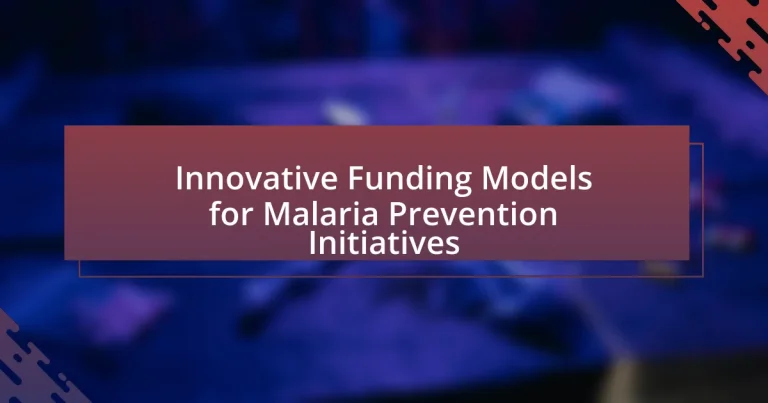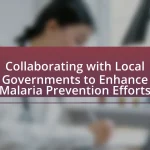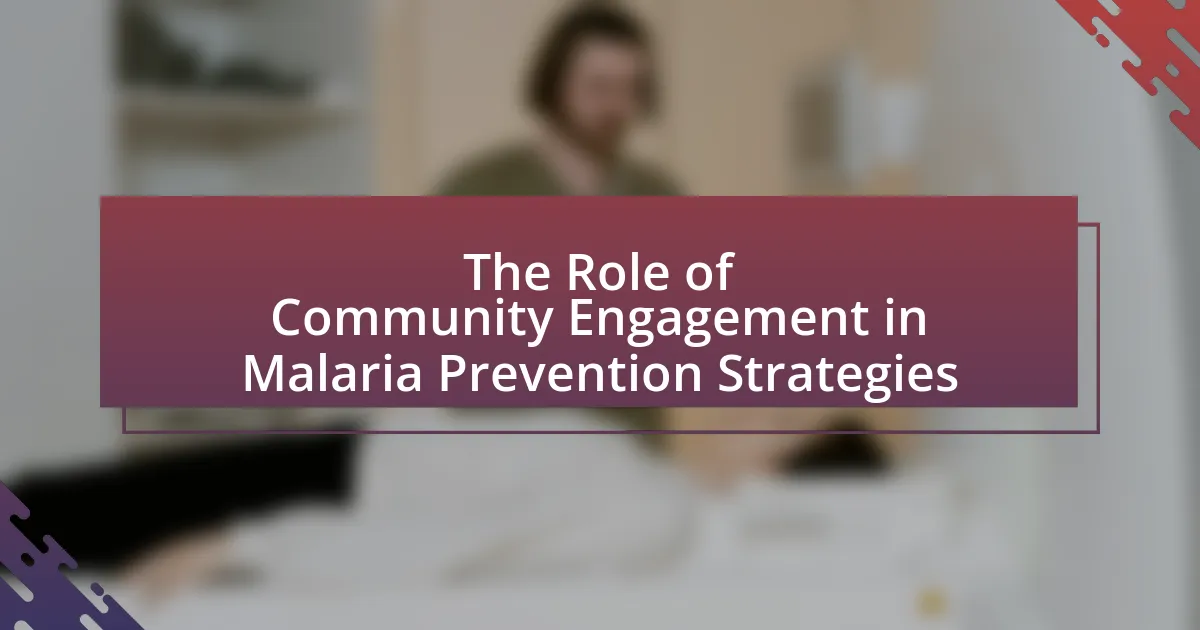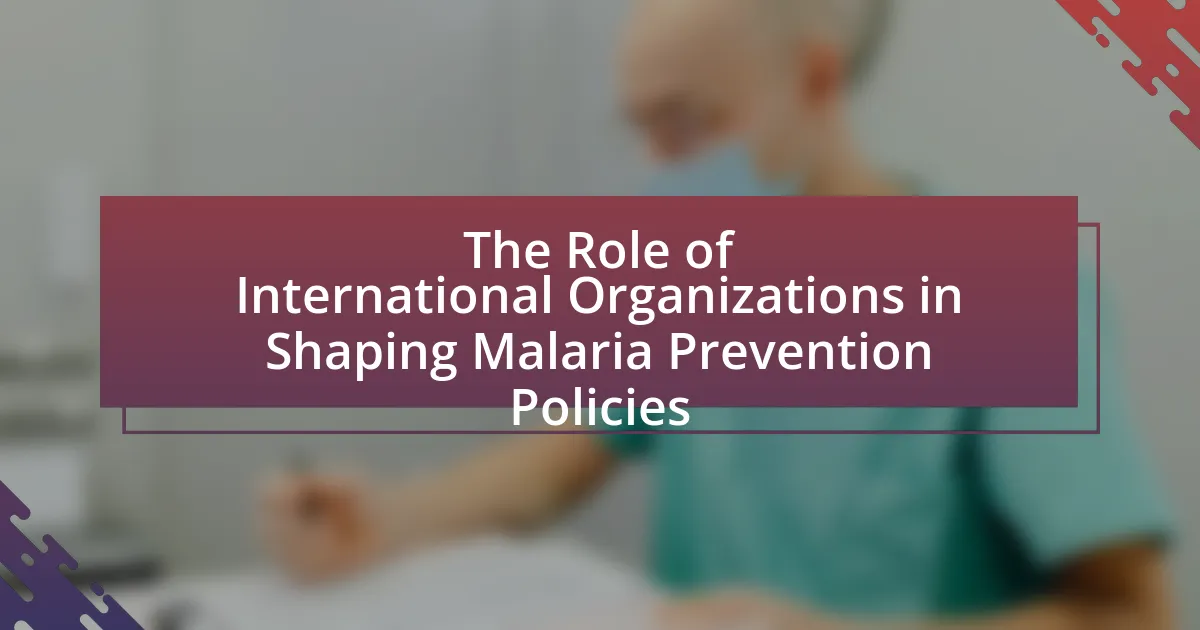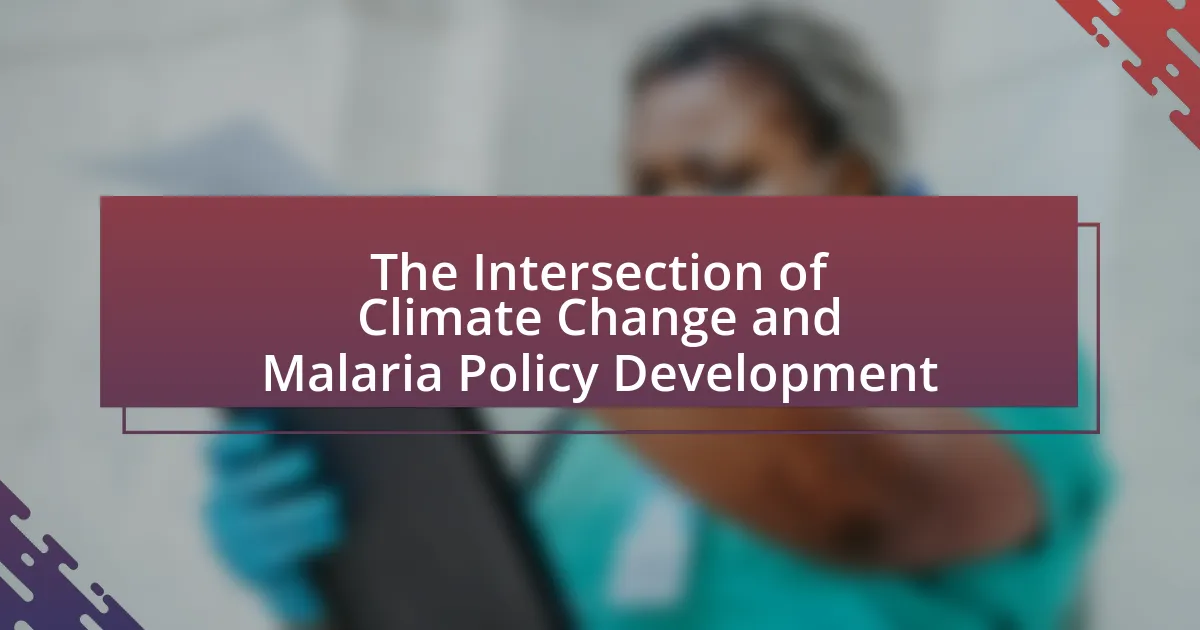Innovative funding models for malaria prevention initiatives encompass strategies such as results-based financing, social impact bonds, and public-private partnerships. These models differ from traditional funding approaches by offering greater flexibility, inclusivity, and adaptability to local needs, ultimately enhancing resource allocation and program sustainability. Key characteristics include collaboration among stakeholders and a focus on measurable health outcomes, which have been shown to improve funding efficiency and effectiveness. The article also addresses challenges faced by these models, such as sustainability and regulatory issues, while highlighting the importance of innovation in mobilizing resources for malaria prevention efforts.

What are Innovative Funding Models for Malaria Prevention Initiatives?
Innovative funding models for malaria prevention initiatives include results-based financing, social impact bonds, and public-private partnerships. Results-based financing ties funding to measurable outcomes, ensuring that resources are allocated effectively based on the success of malaria prevention efforts. Social impact bonds involve private investors funding initiatives with the expectation of returns based on the achievement of specific health outcomes, thus incentivizing effective malaria control measures. Public-private partnerships leverage resources and expertise from both sectors to enhance the reach and efficiency of malaria prevention programs. These models have been shown to improve funding efficiency and effectiveness, as evidenced by successful implementations in various countries, such as the Global Fund’s financing mechanisms that have significantly reduced malaria cases in regions like sub-Saharan Africa.
How do these funding models differ from traditional funding approaches?
Innovative funding models for malaria prevention initiatives differ from traditional funding approaches primarily in their flexibility and inclusivity. Traditional funding often relies on fixed grants from government or large institutions, which can be slow and bureaucratic, whereas innovative models may incorporate diverse sources such as crowdfunding, social impact bonds, and public-private partnerships, allowing for quicker mobilization of resources. For example, the Global Fund to Fight AIDS, Tuberculosis and Malaria utilizes a financing model that combines contributions from various stakeholders, enabling a more adaptive response to emerging needs in malaria prevention. This approach not only accelerates funding availability but also encourages community involvement and accountability, contrasting sharply with the top-down nature of traditional funding mechanisms.
What are the key characteristics of innovative funding models?
Innovative funding models are characterized by flexibility, collaboration, and sustainability. These models adapt to changing circumstances and needs, allowing for diverse funding sources such as public-private partnerships, impact investing, and crowdfunding. Collaboration among stakeholders, including governments, NGOs, and private sectors, enhances resource sharing and expertise, which is crucial for addressing complex issues like malaria prevention. Sustainability is achieved through long-term financial strategies that ensure ongoing support for initiatives, often incorporating performance-based funding mechanisms that align financial incentives with health outcomes. For instance, the Global Fund to Fight AIDS, Tuberculosis and Malaria utilizes innovative financing to mobilize resources effectively, demonstrating the impact of these characteristics in real-world applications.
Why is innovation crucial in funding malaria prevention?
Innovation is crucial in funding malaria prevention because it enables the development of new strategies and technologies that enhance efficiency and effectiveness in combating the disease. Traditional funding models often fall short in addressing the dynamic challenges posed by malaria, such as drug resistance and changing transmission patterns. For instance, innovative funding mechanisms like social impact bonds and public-private partnerships have been shown to mobilize resources more effectively, allowing for targeted interventions that can adapt to local needs. According to the World Health Organization, innovative financing can increase investment in malaria control by up to 50%, demonstrating its potential to significantly impact funding availability and allocation.
What are the main types of innovative funding models used?
The main types of innovative funding models used for malaria prevention initiatives include results-based financing, social impact bonds, and crowdfunding. Results-based financing links funding to the achievement of specific health outcomes, ensuring that resources are allocated efficiently and effectively. Social impact bonds involve private investors funding interventions upfront, with returns based on the success of those interventions in achieving predetermined health outcomes. Crowdfunding leverages online platforms to gather small contributions from a large number of people, democratizing the funding process and increasing community engagement. These models have been shown to enhance resource mobilization and improve the sustainability of malaria prevention efforts.
How does crowdfunding contribute to malaria prevention initiatives?
Crowdfunding significantly contributes to malaria prevention initiatives by providing a platform for individuals and organizations to raise funds directly from the public. This model allows for the mobilization of financial resources that can be allocated to various malaria prevention efforts, such as the distribution of insecticide-treated bed nets, funding for research on vaccines, and community education programs. For instance, initiatives like the “Nothing But Nets” campaign have successfully utilized crowdfunding to distribute millions of bed nets in malaria-endemic regions, demonstrating the effectiveness of this funding approach. Additionally, crowdfunding can engage a broader audience, raising awareness about malaria and encouraging community involvement, which is crucial for the sustainability of prevention efforts.
What role do public-private partnerships play in funding models?
Public-private partnerships (PPPs) play a crucial role in funding models by leveraging resources, expertise, and risk-sharing between the public and private sectors. These collaborations enable the mobilization of financial investments that are essential for large-scale initiatives, such as malaria prevention programs. For instance, the Global Fund to Fight AIDS, Tuberculosis and Malaria has successfully utilized PPPs to enhance funding and implement effective malaria interventions, demonstrating that such partnerships can significantly increase the efficiency and reach of health initiatives.
What challenges do innovative funding models face?
Innovative funding models for malaria prevention initiatives face several challenges, including sustainability, scalability, and stakeholder engagement. Sustainability is a critical issue, as many innovative funding models rely on short-term investments that may not provide long-lasting support for malaria initiatives. For example, funding from philanthropic sources can be unpredictable and may not cover ongoing operational costs. Scalability poses another challenge, as successful pilot programs often struggle to expand due to limited resources or bureaucratic hurdles. Additionally, engaging diverse stakeholders, such as governments, NGOs, and local communities, can be difficult, leading to misalignment of goals and priorities. These challenges hinder the effectiveness and reach of innovative funding models in combating malaria.
How do regulatory issues impact funding for malaria initiatives?
Regulatory issues significantly impact funding for malaria initiatives by creating barriers that can limit access to financial resources. For instance, stringent regulations regarding drug approvals and distribution can delay the implementation of malaria prevention programs, which in turn affects the willingness of investors and donors to commit funds. According to a study published in the journal “Global Health Action,” regulatory hurdles can lead to increased costs and extended timelines for malaria projects, discouraging potential funding sources. Furthermore, compliance with varying international regulations can complicate funding processes, making it less attractive for organizations to invest in malaria initiatives.
What are the risks associated with innovative funding models?
Innovative funding models for malaria prevention initiatives carry several risks, including financial instability, lack of accountability, and potential misalignment of incentives. Financial instability arises when funding sources are uncertain or contingent on external factors, which can jeopardize long-term project sustainability. Lack of accountability can occur if funding is not tied to clear performance metrics, leading to inefficient use of resources. Additionally, misalignment of incentives may happen when funders prioritize short-term outcomes over long-term impact, potentially undermining the effectiveness of malaria prevention efforts. These risks highlight the need for careful planning and monitoring in the implementation of innovative funding models.

How can innovative funding models enhance malaria prevention efforts?
Innovative funding models can enhance malaria prevention efforts by providing flexible financial resources that adapt to local needs and challenges. These models, such as social impact bonds and crowdfunding, enable stakeholders to invest in targeted interventions, ensuring that funds are allocated efficiently and effectively. For instance, the Global Fund to Fight AIDS, Tuberculosis and Malaria has successfully utilized innovative financing mechanisms to mobilize over $4 billion for malaria prevention, demonstrating the potential for increased funding to directly impact malaria control initiatives. By leveraging diverse funding sources, these models can also foster collaboration among governments, NGOs, and private sectors, leading to more comprehensive and sustainable malaria prevention strategies.
What are the measurable impacts of these funding models on malaria prevention?
Innovative funding models significantly enhance malaria prevention efforts by increasing resource allocation and improving program sustainability. For instance, the Global Fund to Fight AIDS, Tuberculosis and Malaria reported that investments in malaria programs led to a 29% reduction in malaria mortality rates between 2010 and 2019 in supported countries. Additionally, targeted funding initiatives, such as the Malaria Vaccine Implementation Program, have facilitated the deployment of new vaccines, resulting in a 30% decrease in malaria cases in pilot regions. These funding models not only provide immediate financial support but also foster long-term partnerships that strengthen health systems, ultimately leading to measurable improvements in malaria prevention outcomes.
How do innovative funding models improve resource allocation?
Innovative funding models improve resource allocation by enabling more efficient and targeted distribution of financial resources to malaria prevention initiatives. These models, such as results-based financing and social impact bonds, align funding with specific outcomes, ensuring that resources are directed towards programs that demonstrate effectiveness in reducing malaria incidence. For instance, the Global Fund to Fight AIDS, Tuberculosis and Malaria utilizes performance-based funding, which incentivizes countries to achieve measurable health outcomes, thereby optimizing the use of funds and maximizing impact. This approach not only enhances accountability but also encourages innovation in program delivery, leading to better health outcomes and more effective use of limited resources.
What success stories illustrate the effectiveness of these models?
Innovative funding models for malaria prevention initiatives have demonstrated effectiveness through various success stories. One notable example is the Global Fund to Fight AIDS, Tuberculosis and Malaria, which has mobilized over $4 billion for malaria programs since its inception in 2002, significantly reducing malaria mortality rates in countries like Zambia and Uganda. Additionally, the Affordable Medicines Facility – malaria (AMFm) initiative improved access to artemisinin-based combination therapies, leading to a 50% reduction in malaria cases in several African nations. These models showcase how targeted funding can lead to substantial public health improvements and reduced disease burden.
How do stakeholders benefit from innovative funding models?
Stakeholders benefit from innovative funding models by gaining access to diversified financial resources that enhance project sustainability and impact. These models often leverage public-private partnerships, enabling stakeholders to share risks and rewards, which can lead to increased investment in malaria prevention initiatives. For instance, the Global Fund to Fight AIDS, Tuberculosis and Malaria has successfully utilized innovative financing mechanisms, such as social impact bonds, to mobilize additional funding, resulting in improved health outcomes in affected regions. This collaborative approach not only amplifies funding but also fosters innovation and efficiency in resource allocation, ultimately benefiting stakeholders involved in malaria prevention efforts.
What incentives do investors have in funding malaria prevention?
Investors have several incentives for funding malaria prevention, primarily driven by the potential for significant social impact and financial returns. By investing in malaria prevention initiatives, investors can contribute to reducing the global burden of malaria, which affects over 200 million people annually and results in approximately 400,000 deaths, predominantly among children in sub-Saharan Africa. This social impact can enhance an investor’s reputation and align with corporate social responsibility goals. Additionally, malaria prevention can lead to economic benefits, as healthier populations contribute to increased productivity and reduced healthcare costs. For instance, the World Health Organization estimates that every dollar invested in malaria prevention can yield a return of up to $36 in economic benefits. Thus, the combination of social impact, reputational enhancement, and potential financial returns serves as strong incentives for investors in malaria prevention initiatives.
How do communities engage with these funding models?
Communities engage with innovative funding models for malaria prevention initiatives by actively participating in decision-making processes and contributing local knowledge. This engagement often includes forming partnerships with NGOs and government agencies to identify funding opportunities, such as grants and microfinancing, tailored to their specific needs. For instance, community-led initiatives have successfully leveraged crowdfunding platforms to raise awareness and funds for local malaria prevention projects, demonstrating a direct link between community involvement and financial support. Additionally, studies show that when communities are involved in the planning and implementation of funding models, the effectiveness of malaria prevention efforts increases, as seen in various regions where local stakeholders have taken ownership of health initiatives.
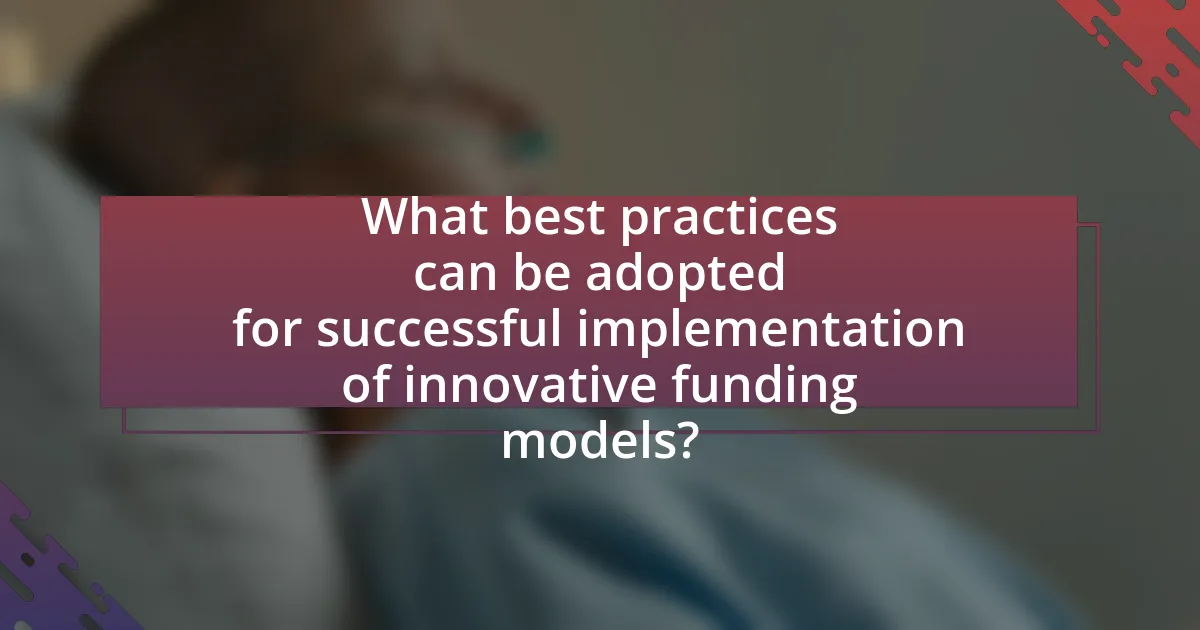
What best practices can be adopted for successful implementation of innovative funding models?
Successful implementation of innovative funding models for malaria prevention initiatives requires establishing clear objectives and measurable outcomes. Defining specific goals allows stakeholders to align their efforts and resources effectively. Engaging diverse stakeholders, including government agencies, NGOs, and private sector partners, fosters collaboration and resource sharing, which enhances funding sustainability. Utilizing data-driven approaches to assess funding needs and impact ensures that resources are allocated efficiently, maximizing the effectiveness of interventions. Additionally, leveraging technology for transparency and accountability in funding processes builds trust among stakeholders and encourages continued investment. Evidence from successful malaria funding initiatives, such as the Global Fund to Fight AIDS, Tuberculosis and Malaria, demonstrates that these practices lead to improved health outcomes and increased funding efficiency.
What strategies can enhance the effectiveness of funding models?
Diversifying funding sources enhances the effectiveness of funding models for malaria prevention initiatives. By incorporating a mix of public, private, and philanthropic funding, organizations can reduce dependency on a single source, thereby increasing financial stability and resilience. For instance, the Global Fund to Fight AIDS, Tuberculosis and Malaria has successfully utilized a combination of government contributions, private sector investments, and donations from individuals to support its initiatives, resulting in a more robust funding framework. Additionally, leveraging technology for crowdfunding and engaging local communities can further amplify resource mobilization, as evidenced by successful campaigns that have raised millions for health initiatives.
How can collaboration among stakeholders improve funding outcomes?
Collaboration among stakeholders can significantly improve funding outcomes by pooling resources, expertise, and networks to create a more compelling case for investment. When diverse stakeholders, such as government agencies, non-profits, and private sector partners, work together, they can leverage their unique strengths to address complex challenges in malaria prevention. For instance, a study by the Global Fund indicates that collaborative funding models can increase resource mobilization by up to 30%, as stakeholders can present a unified strategy that demonstrates a broader impact and shared accountability. This collective approach not only enhances credibility but also attracts additional funding from donors who prefer to invest in well-coordinated initiatives with measurable outcomes.
What role does transparency play in successful funding initiatives?
Transparency is crucial in successful funding initiatives as it fosters trust among stakeholders, including donors, recipients, and the community. When funding processes are transparent, stakeholders can clearly see how funds are allocated and utilized, which enhances accountability and encourages continued support. For instance, a study by the Global Fund to Fight AIDS, Tuberculosis and Malaria found that transparency in financial reporting led to a 30% increase in donor confidence and contributions. This demonstrates that transparency not only improves the effectiveness of funding initiatives but also attracts more resources for malaria prevention efforts.
What are the future trends in innovative funding for malaria prevention?
Future trends in innovative funding for malaria prevention include the increased use of blended finance, impact investing, and digital financing solutions. Blended finance combines public and private funding to leverage additional resources, as seen in initiatives like the Global Fund, which has successfully mobilized billions for malaria control. Impact investing focuses on generating social and environmental benefits alongside financial returns, attracting investors interested in sustainable development. Digital financing solutions, such as mobile payment systems and blockchain technology, are emerging to streamline funding processes and enhance transparency, facilitating quicker and more efficient resource allocation. These trends reflect a shift towards more collaborative and technology-driven approaches to funding malaria prevention efforts.
How might technology shape the future of funding models?
Technology will significantly shape the future of funding models by enabling more efficient, transparent, and accessible financial transactions. Innovations such as blockchain can provide secure and traceable funding pathways, ensuring that donations reach intended malaria prevention initiatives without loss or misallocation. Additionally, crowdfunding platforms leverage social media to engage a broader audience, allowing smaller contributions to accumulate into substantial funding for projects. According to a report by the World Health Organization, digital payment systems have increased funding accessibility in low-income regions, facilitating quicker responses to malaria outbreaks. These advancements indicate that technology will enhance the effectiveness and reach of funding models in public health initiatives.
What emerging funding sources could be explored for malaria initiatives?
Emerging funding sources for malaria initiatives include impact investing, blockchain technology, and public-private partnerships. Impact investing focuses on generating social and environmental benefits alongside financial returns, attracting capital from investors interested in health outcomes. Blockchain technology can enhance transparency and traceability in funding allocation, potentially increasing donor confidence and participation. Public-private partnerships leverage resources and expertise from both sectors, facilitating innovative solutions and shared financial responsibility. These funding sources are increasingly recognized for their potential to mobilize resources effectively in the fight against malaria.
What practical steps can organizations take to implement innovative funding models?
Organizations can implement innovative funding models by diversifying their funding sources, leveraging technology for crowdfunding, and establishing partnerships with private sector entities. Diversifying funding sources allows organizations to reduce reliance on traditional grants and explore options such as social impact bonds, which have been shown to attract private investment for public health initiatives. Leveraging technology for crowdfunding can mobilize community support and raise funds through platforms that facilitate small donations from a large number of individuals, as evidenced by successful campaigns in various health sectors. Establishing partnerships with private sector entities can provide access to additional resources and expertise, enhancing the sustainability of funding efforts, as seen in collaborations between NGOs and corporations in malaria prevention programs.
